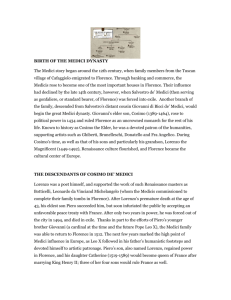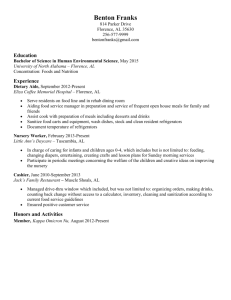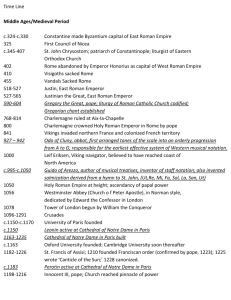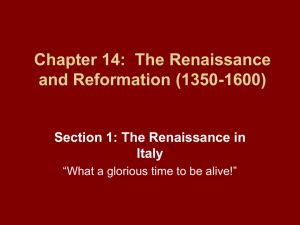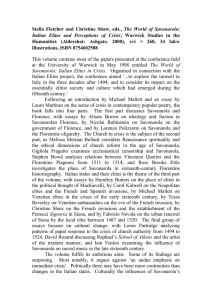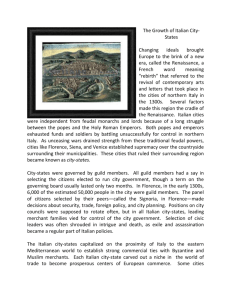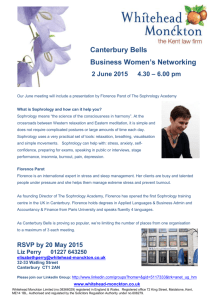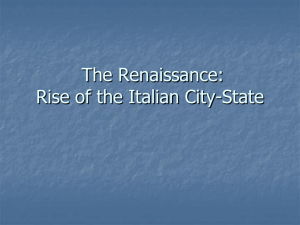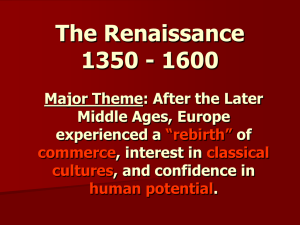Humanities 3 I. The Italian Renaissance
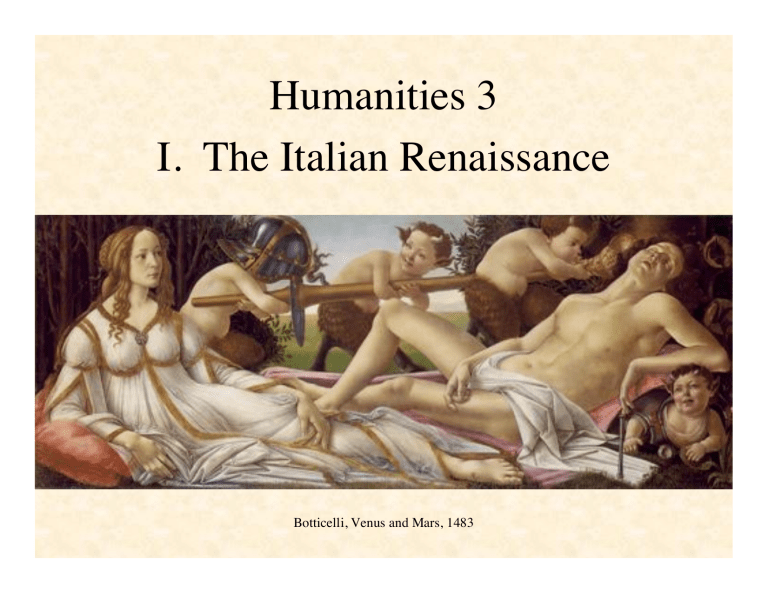
Humanities 3
I. The Italian Renaissance
Botticelli, Venus and Mars, 1483
Lecture 3
Religion and Politics
Outline
• Florence under the Medici
• Florence: New Athens or New Jerusalem?
• The Rise and Fall of Savonarola
Florence under the Medici
(1434-1492)
• Florence traditionally a republic: a free city-state governed by a constitution; citizens serve as legislators, chosen by lot or ballot.
• 1434 Cosimo de’ Medici (1389-1464) returns from exile and seizes power in Florence ; gradually erodes its constitution.
• 1464 Cosimo succeeded by his son Piero, and then his grandson Lorenzo (1469) as rulers of Florence.
• 1475 Sandro Botticelli (1445-1510) begins a series of paintings under the patronage of the Medici family.
Botticelli,
Adoration of the Magi ,
1475
• 1478 Pope Sixtus IV is part of a plot (the
Pazzi conspiracy) to overthrow the Medici.
Lorenzo escapes assassination attempt, but his brother Guiliano is killed.
• 1479 Lorenzo excommunicated by Sixtus; armies of the pope and king of Naples move against Florence. Sixtus excommunicated by Tuscan bishops. Parties reconcile the following year.
• 1492 Death of Lorenzo
Paradox of the Medici
• Florence under the Medici is an oligarchy (rule of the few), where power rest with a handful of wealthy individuals connected to the Medici by ties of blood and personal loyalty.
• Yet the Medici are responsible for much of what we admire about the Florentine Renaissance: the rebirth of literature, philosophy, and art.
• The cultural program of the Medici is the revival of the values and art forms of the classical (pagan) world.
Botticelli, Primavera , c. 1482
Part One
• Venus, the goddess of love and marriage, reigns in her garden, a place of eternal springtime.
• With her is her son, Cupid, and his father
Mercury, who guards the entrance to the garden and deflects the dark clouds.
• Venus’s attendants, the Graces, are virgins, symbols of purity, one of whom is about to be struck by Cupid’s arrow.
Part Two
• According to another myth, the nymph
Chloris is carried off by Zephyr, whereupon she is transformed into the goddess Flora.
• The two figures at the far right of Primavera represent a time prior to the appearance of
Flora, who has the poise and maturity of a married woman. (Is she also pregnant?)
Mercury Graces Cupid/Venus Flora Chloris Zephyr
Part Three
• Primavera was commissioned from
Botticelli by Lorenzo di Pierfrancesco de’
Medici (grandson of the brother of Cosimo) to commemorate his marriage to
Semiramide d’Appiano in May 1482.
• It is meant to convey the idea that love leads to a happy and fruitful marriage.
Pallas and the
Centaur , 1482
Venus and Mars , 1483
Botticelli, Birth of Venus, c. 1485
The Platonic Academy
• 1464 Cosimo provides Marsilio Ficino with manuscripts containing all of Plato’s surviving works and orders them to be translated into Latin
(brought to Italy after the fall of Constantinople in
1453)
• 1473 Lorenzo founds the Platonic Academy, whose members include the philosophers Ficino and Giovanni Pico della Mirandola, and the poet
Angelo Poliziano.
• 1486 Pico publishes Oration on the Dignity of
Man as the preface to a book of 900 theses, which he proposes to defend publicly in Rome . The book is banned by the pope.
God: “We have given to thee, Adam, no fixed seat, no form of thy very own […] Thou canst grow downward into the lower natures which are brutes. Thou canst again grow upward from thy soul’s reason into the higher natures, which are divine.” (from Pico’s Oration )
Pico’s Philosophy
• Human beings are at the center of the cosmos, midway between the bestial and divine.
• Our nature is “plastic,” we can mold it as we choose: we are “born in this state so that we may be what we will to be.”
• Each of us has the potential for a spiritual
“rebirth”: we can “grow upward… into the higher natures which are divine.”
Perfection
Illumination
(wisdom)
Purgation
(dialectic, moral philosophy)
Ascent to God
Union with God
(Peace, Happiness)
Contemplation of Divine Things
(Intellect)
Natural Philosophy
(Reason)
Bodily Experience
(Sensation/Emotion)
Ancient Wisdom
The same wisdom is found in many sources, which illuminate each other: Christianity,
Judaism, and ancient pagan philosophy, especially Plato, who is understood to have inherited his wisdom from the “thrice-great
Hermes” (Hermes Trismegistus).
Cabala and the Conversion of the Jews
• Cabala is the esoteric “true” meaning of the divine law given to Moses.
• According to Pico, this meaning contains the revealed truth of Christianity.
• This is illustrated through the interpretation of Genesis 1:1-27 in Pico’s book Heptaplus.
“When I had procured myself these books at no small expense and had read them through… I saw in them… a religion not so much Mosaic as
Christian…. In short, there is hardly any dispute between us and the Hebrews on this wherein they cannot be so disproved and refuted from the books of the Cabalists that there is no corner left in which they may hide.” ( Oration )
Florence: New Athens or
New Jerusalem?
• Platonic philosophers such as Ficino and
Pico saw no contradiction between the wisdom of the ancients and Christianity.
• Others, following St. Paul and St.
Augustine, saw the two worldviews as essentially at odds with each other.
• The conflict between these groups came to a head in late 15th-century Florence (as it did later during the Reformation).
The Rise and Fall of Savonarola
1481 Domenican friar
Giorlamo Savonarola
(1452-98) arrives in
Florence; stays for five years.
1490 Savonarola returns to Florence and begins to preach against the decadence of the city. He prophesies divine retribution if the
Florentines do not comply.
1491 Savonarola is elected prior of the monastery of
San Marco.
Savonarola on Philosophers
• “Since they did not have true knowledge of the end of human life, the least child of the Christians is better than them.”
• The big question: is the end of human life
(salvation, blessedness) attained through art and philosophy, or through faith in Jesus Christ?
The Savonarola Years, 1492-98
• April 1492 Lorenzo dies aged 43 and is succeeded by his son Piero.
• August 1492 Rodrigo Borgia attains the papacy by simony and takes the name Alexander VI. He fathers seven children with two mistresses.
• Savonarola denounces the moral corruption of the pope, and preaches a return to a pious, biblically based Christian life.
Rodrigo Borgia, Pope
Alexander VI
His mistress,
Guilia Farnese
• 1494 Death of Pico, who is reported to have confessed his sins to Savonarola
• Under an agreement with Piero, Charles VIII of
France enters Florence and occupies Pisa. The people rise up and drive the Medici from Florence.
(This had been predicted by Savonarola: “Behold the scourge has fallen; the prophecies are being fulfilled”).
• Savonarola proposes that Florence be governed as a republic under religious law (a populist reform that rejected the Medici’s “rule of the few”).
• 1495 Legislation passed to expel all Jews from
Florence.
• 1497 Savonarola excommunicated by the pope.
Atmosphere of religious frenzy in Florence
(“bonfire of the vanities”).
• 1498 Savonarola narrowly avoids “trial by fire,” but the people turn against him. He is hanged and burned for heresy on May 23, 1498.
• Pier Soderini reinstates the republic; Machiavelli employed by the signoria .
“The people of Florence seemed to be neither illiterate nor rude, yet they were persuaded that God spoke through
Savonarola.”
Machiavelli
